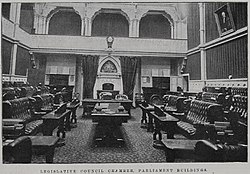Legislative Council of New Zealand
| Legislative Council of New Zealand | |
|---|---|
| Type | |
| Type |
Upper house of the General Assembly of New Zealand
|
| History | |
| Established | 1 July 1841 |
| Disbanded | 1 January 1951 |
| Leadership | |
| Elections | |
| Appointed by Governor-General | |
| Meeting place | |
 The original plenary chamber, photographed in 1899 |
|
| Parliament House, Wellington | |
| Footnotes | |
|
^ a. Parliament was titled the "General Assembly of New Zealand" before 1986 ^ b. Final sitting on 1 December 1950. |
|
|
|
|
|
The Legislative Council of New Zealand existed from 1841 until 1951. When New Zealand became a colony in 1841 the Legislative Council was established as the country's first legislature; it was reconstituted as the upper house of a bicameral legislature when New Zealand became self-governing in 1852.
Unlike the elected lower house, the House of Representatives, the Legislative Council was wholly appointed by the Governor-General. The New Zealand Constitution Act 1852 had authorised the appointment of a minimum of ten councillors. Beginning in the 1890s, the membership of the upper house became controlled by government of the day. As a result, the Legislative Council possessed little influence. While intended as a revising chamber, in practice, debates and votes typically simply replicated those in the lower house. It was abolished by an Act of Parliament in 1950, with its last sitting in December 1950.
The Legislative Council was established by the Charter for Erecting the Colony of New Zealand on 16 November 1840, which created New Zealand as a Crown colony separate from New South Wales on 1 July 1841. Originally, the Legislative Council consisted of the Governor, Colonial Secretary and Colonial Treasurer. The Legislative Council had the power to issue Ordinances, statutory instruments.
With the passing of the New Zealand Constitution Act 1852, the Legislative Council became the upper house of the General Assembly in 1853.
The Legislative Council was intended to act as a revising chamber, scrutinising and amending bills which had been passed by the House of Representatives. It could not initiate bills, and was prohibited from amending money bills (legislation relating to finance and expenditure). The model for the Legislative Council's role was the House of Lords in the United Kingdom.
...
Wikipedia
